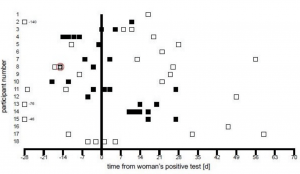Disclaimer: This is a summary of an article that is in a preprint and has not been peer reviewed.

Breastmilk Sampling Relative to Time of Woman’s Positive SARS-CoV-2 Test. Filled and unfilled boxes indicate breastmilk samples that were collected when the woman was symptomatic and asymptomatic, respectively. All samples were tested for SARS-CoV-2 viral RNA by PT-PCR. Samples from participants 1-10, excluding participant 3, were also tested in infectivity assay. The sample highlighted by asterisk tested positive by RT-PCR, but negative by infectivity assay. (source: Chambers et al., Pre-print)
Authors in a pre-peer reviewed article established a quantitative RT-PCR assay for SARS-CoV-2 in breastmilk with a limit of detection of 250 copies per mL. They applied this to a series of 64 serial breastmilk samples from 18 SARS-CoV-2-infected women and found viral RNA in only one sample. After viral culture, they found the viral sample to be replication-incompetent and concluded that breast milk is not a source of SARS-CoV-2 infection to infants. Additionally, when control breastmilk samples were spiked with replication-competent SARS-CoV-2 virus and treated by Holder pasteurization no replication-competent virus nor viral RNA was detectable. These results suggest that the presence of SARS-Cov-2 in breast milk is not common and that using a standardised pasteurization procedure, any presence of virus is destroyed.
Pre-print: Chambers et al., Pre-print: Evaluation of SARS-CoV-2 in Breastmilk from 18 Infected Women. MedRxiv
Summary by Clive Gray










